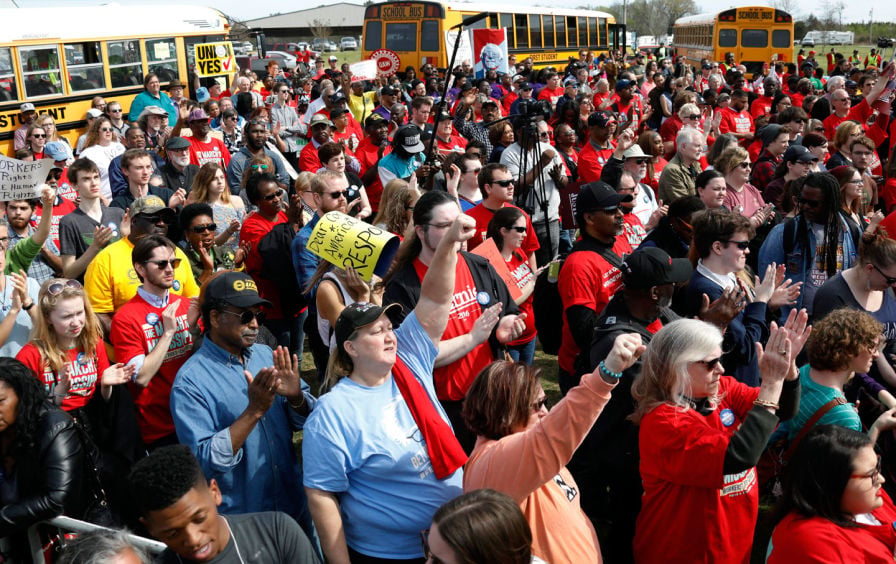How the Left Can Win in the South
By Paul BlestTwitter / The Nation
22 يوليو 2017

Bernie Sanders didn’t just lose the South in the 2016 Democratic primary—he got destroyed in it.
The Vermont senator lost all 11 states that made up the Confederacy to his opponent, Hillary Clinton—and most of them by huge margins. Clinton won by nearly 50 points in South Carolina, almost 60 in Alabama, and a whopping 66 points in Mississippi. In all, Clinton won around 5.1 million votes to Sanders’s estimated 2.5 million. Without such a poor showing in the region, his party’s nomination might have been within Sanders’s reach.
But despite the thorough ass-kicking he received here last year, there’s hope that progressive and leftist candidates can compete against the wave of red that’s washed over the South since the passage of the Civil Rights Act.
The unprecedented mobilization of progressives that has followed the election of Donald Trump is providing a historic opportunity to build an organized and formidable American left. But it will take time, investment, and a commitment to the efforts that are already taking place in the South to turn a historically conservative region into a progressive bastion.
As the Democratic primary showed, the left needs to be able to win in the South in order to gain national power. This, however, will require a new approach, one that prioritizes the votes of working-class people of color over those of suburban Republicans losing their stomach for the antics of the Trump administration.
“You’re not gonna win people over in the South with a tweet or a Facebook post,” says Our Revolution’s newly appointed president, Nina Turner, a former state senator from Ohio and a prominent Sanders surrogate. “It’s getting out there and pressing the flesh and listening to people’s hopes and dreams…. we have to work and have stronger efforts to not just say people need decent wages or a decent place to live, but good wages and a good place to live.”
Bernie Sanders may be the most popular politician in the country today, but his defeat across the South should have been a wake-up call for the left. Future candidates must learn from his missteps if they’re serious about winning.
The national presidential campaign didn’t invest as many resources here as in other states. For example, Sanders essentially wrote off the South Carolina primary (with the exception of a few last-minute events the week before) in favor of campaigning in March-primary states like Massachusetts, Oklahoma, and Ohio.
The fact that the 11 states that made up the Confederacy all held their Democratic primaries by March 15 didn’t help. “One of the biggest problems was time,” says Justin Bamberg, a state representative from South Carolina and the lawyer for the families of Walter Scott, Keith Scott, and Alton Sterling. Bamberg switched his endorsement from Hillary Clinton to Bernie Sanders in January 2016. “Bernie picked up momentum as time went on, but there just wasn’t enough time for people down here to get to know him, particularly when you’re running against someone with 100 percent name recognition.”
Because of the Democratic Party’s virtual disappearance in the Deep South outside of urban areas, the circle of influential voices has gotten tighter. “In the South, when it comes to Democratic elections, black churches carry a lot of weight,” Bamberg says, “and your ability to get into those circles makes a big difference in how well you’re gonna do in your campaign.” Clinton was able to do this in a way Sanders wasn’t.
Jillian Johnson, a left-wing City Council member from Durham, North Carolina, who supported Sanders, says that the campaign’s opening stumbles on race issues, such as a disastrous appearance at Netroots Nation, were critical. “Not being able to speak competently about race issues was a huge issue for Bernie, and I think that’s really important,” she says.
Sanders’s failure to win over black voters, owing to all of these factors, was disastrous. In order for the left to win in the South, it must demonstrate an ability to create a strong and sustainable coalition in spite of the one of the main historical obstacles to progress in America: racism.
“When you look at the history of the American South, you often need at least some cross-racial collaboration,” says Robert Greene, a PhD candidate at the University of South Carolina. “But the problem is that, so many times in Southern history, racism has been used as a wedge between white and black Southerners who might otherwise have some common ground on key issues.”
Bamberg, who represents the rural, majority-black Bamberg County in the South Carolina legislature, says Sanders’s emphasis on economic justice may resonate with voters who usually see no reason to vote. “Hell, come to where I live, we have a city where the average family makes $15,000 a year…. It’ll take time for things to change, but the seed has been planted and it’ll continue to be watered.”
As the nonprofit Feeding America notes, the South has the highest rural-poverty rate of any region in the country—25 percent. Some of these rural poor are Democrats, some are Republicans, many don’t vote at all—but none of them are benefiting from austerity policies. Turning non-voting poor and working-class people into reliable voters is a viable strategy, but it requires a plan to make their lives better.
It also means reaching African Americans—particularly older African Americans—in a way that Sanders wasn’t able to. That takes organizing and investment in years where there isn’t a presidential election, rather than writing off the region as unwinnable. Sanders’s woes in the South reflect “the degree to which presidential campaigns are not the right place to change the overall dynamics of a political party,” Jamelle Bouie wrote during last year’s primary. “To win over black voters, Sanders and his supporters needed to spend time in black communities, becoming a part of their politics—a trusted partner.”
A winning strategy must also take into account the changing demographics of the South, and the potential to meld new constituencies into a winning coalition. “When people think of the Latino vote, they tend to think of it in the Southwest or West, but in fact the Latino vote is nationwide,” Greene says. “And in states like the Carolinas, Georgia, Alabama, states that have larger and larger numbers of immigrants coming in from Central America and Mexico, we really need to start thinking about how to build a coalition that also includes them.”
There is historical precedent for such a multiracial progressive campaign in the South—including one that Sanders himself was a part of. In 1984 and 1988, Rev. Jesse Jackson ran for president on a platform that tied social-justice issues like police accountability, voting rights, and civil rights to economic issues like farm debt.
“As the Rainbow Coalition reaches beyond its primary constituency to include an array of new ones, the values espoused are incorporated into the growing movement,” The Nation’s editors wrote in their 1988 endorsement of Jackson. “When unionists, feminists, Hispanics, Asian-Americans, students, civil libertarians and community activists join or endorse the Rainbow campaign, they contribute their ideals and their energies while they share the coalition’s strength.” Jackson eventually finished runner-up in his second run for president, winning 11 contests during the primary. The majority of his wins came in Southern states: Alabama, Georgia, Louisiana, Mississippi, South Carolina, and Virginia.
“Jackson was able to make specific appeals to poor white voters based around class issues,” Greene says. “It wasn’t just about fighting racial injustice, even though that was at the core of his platform. He also spent a lot of time talking about economic injustice, to an extent that, even in the 1980s, most Democrats weren’t really comfortable with.”
Thirty years later, civil-rights leader Rev. Dr. William Barber is carrying on the tradition that dates back to the late-19th-century Fusionist movement in North Carolina. As he wrote in The Nation:
After the Civil War, newly freed African Americans found common cause with white North Carolinians, wrote a new state constitution and founded the South’s first public-school system. In the 1890s, their political descendants formed an interracial “Fusion coalition” of white populists and black Republicans, which won the governorship and every state-wide office in 1896. White conservatives overthrew the Fusionist government by force and fraud, installing a one-party state that disfranchised blacks and ushered in lynch law and Jim Crow segregation. Still, the memory of fusion politics did not die.
Barber’s Moral Movement—inspired by the legacy of fusion politics—offers perhaps the best blueprint for building a broad-based coalition in the South. Over the past six years of Republican control in state government, Barber’s Moral Movement has grown out of opposition to the marriage of social and economic conservatism behind policies like heavy cuts to public services and the anti-trans, anti-worker “bathroom bill” HB 2.
The Moral Movement’s annual march draws tens of thousands of people from social-justice groups working on immigration, labor and workers’ rights, environmental justice, civil rights, and health care. This year, in the wake of Trump’s election, the state NAACP said it was their largest march thus far. “I like to say we have blacks, whites, Latinos, young, old, we have rural, we have urban, we have gay, we have straight, we have Muslim, Christian, Sikh, Hindu all coming together in the Deep South,” Barber told Sanders in a conversation in February.
Despite its losing the Democratic nomination, one outcome of the Sanders campaign that seems to be enduring is the popularization of democratic socialism all across the country, including in the South. Democratic Socialists of America has seen membership more than double since November, from over 8,000 in the day before the presidential election to over 24,000 currently. According to its website, DSA currently has 40 DSA chapters, organizing committees, and YDS groups in the former Confederate states. Many of these are brand new. (Full disclosure: I’m a member of the North Carolina Piedmont DSA.)
And leftist candidates have already been winning local elections in the South. In April, the DSA- and Our Revolution–endorsed khalid kamau won election to a City Council seat in the newly chartered city of South Fulton, Georgia. And in June, the leftist Chokwe Antar Lumumba won the mayoralty of Jackson, Mississippi, and pledged to make Jackson the “most radical city on the planet.”
Johnson, who was elected to the Durham City Council in 2015, has shown the importance of left-wingers at the city level by pressing progressive policies in a state that’s been dominated by Republicans for almost a decade. Johnson has won reforms in key areas like marijuana de-prioritization and a $15 minimum wage for all city employees. Right now, Johnson is pushing for participatory budgeting in Durham.
Johnson’s suggestions for building the left at the local level and beyond are simple: run a diverse slate of candidates, invest in local progressive causes, and—perhaps most importantly—organize around people, not elections. “There will be moments when national organizations want to fund the South, but in between major elections, there’s nothing,” she says. “We can be working to build community engagement all the time. There’s a real danger in only building a structure around elections.”
Labor has traditionally been a key factor in organizing the left’s base in non-election years. Unions provide an entry point into politics for the working class. In March, Sanders, former Ohio state senator Nina Turner, and NAACP president Cornell Williams Brooks rallied for workers’ rights at a Nissan factory in Mississippi (the state where Sanders got his second-smallest share of primary votes, after the US Virgin Islands). “If Mississippi Nissan workers succeed,” Sanders said, “it will send a powerful message in the South and across this country that working people are prepared to fight for justice.”
But unions are up against the weight of history. While organized labor is starting to make a stronger push in the region, the South has traditionally been one of the least unionized areas of the country, dating back to Jim Crow. The AFL-CIO’s current campaign to organize the South has seen some crushing blows recently, like the February defeat of a union at a Boeing plant in South Carolina. But a few recent victories, including in pushing local Democrats officials to the left on workers’ rights in places like Miami and Dallas, offer glimmers of hope. For that reason, fighting to overturn legal obstacles to labor in the South—such as restrictions on collective bargaining for public-sector unions—is a critical battle, even if it promises to be a long one.
To be sure, there are stark challenges facing the left in the South. But from the late-19th-century Fusionist movement in North Carolina to West Virginia’s rich labor history to the Mississippi Freedom Democratic Party, victories for racial and economic justice have started in the place where rights have been trampled the most. And the backlash against that progress has roots in the South as well: Jim Crow as retribution for Reconstruction and, more recently, the emergence of Tea Party rule in the Obama era.
“We have to look at this as a deeply long-term strategy, they can’t just look at this in terms of the next election or the next cycle,” Greene says. Building a successful Southern left—one that not only harkens back to the successes of the Fusion alliance and the Rainbow Coalition but institutionalizes change in the South in a way those movements were ultimately unable to—is a project that may take years, even decades, to bear fruit.
And in order to win, Greene says, it’s going to take an organized effort by all of these groups on the left—Our Revolution and the DSA included—to support the movements that have been doing work here for years. “I think providing a support role, and helping those campaigns link up with each other and really build a broad-based coalition, is really where the future of the party or the future of progressivism lies in the South,” Greene says.
“Clinton really got into the South hard,” Turner remembers from the primary. “The lesson to be learned there is to get in there now, and to build the relationships now…. what Reverend Barber has done is nothing short of spectacular. So it’s getting in there and doing the work [to support that]. We’re not coming in there to dictate.”
 عن أمل جنبلاط المتجدد: لبنان يستحق النضال
عن أمل جنبلاط المتجدد: لبنان يستحق النضال
 صحافيون أم عرّافون!
صحافيون أم عرّافون!
 ماذا يجري داخل أروقة بيت الكتائب المركزي؟
ماذا يجري داخل أروقة بيت الكتائب المركزي؟


 عن الخرائط التي تُرسم والإتفاقات التي تتساقط!
عن الخرائط التي تُرسم والإتفاقات التي تتساقط!
 “الإنحراف في الحياة”/ بقلم كمال جنبلاط
“الإنحراف في الحياة”/ بقلم كمال جنبلاط
 هاشتاغ #صار_الوقت يحل أولاً في حلقة جنبلاط
هاشتاغ #صار_الوقت يحل أولاً في حلقة جنبلاط
 طاولة نقاش عن أزمة الصحافة في جامعة AUST
طاولة نقاش عن أزمة الصحافة في جامعة AUST
 عبدالله: ليظهر لنا وزير مكافحة الفساد حرصه في صفقات البواخر والفيول
عبدالله: ليظهر لنا وزير مكافحة الفساد حرصه في صفقات البواخر والفيول
 عبدالله: غريب أمر وزارة مكافحة الفساد!
عبدالله: غريب أمر وزارة مكافحة الفساد!

 Comment to Uri Avnery: How Sad What Is Looming Ahead
Comment to Uri Avnery: How Sad What Is Looming Ahead
 “Not Enough!”
“Not Enough!”
 … لمن لم يقرأ يوسف البعيني/ بقلم وسام شيّا
… لمن لم يقرأ يوسف البعيني/ بقلم وسام شيّا
 كمال جنبلاط في مولده الأول بعد المائة: تعاليمه وأفكاره ما زالت الحلّ/بقلم عزيز المتني
كمال جنبلاط في مولده الأول بعد المائة: تعاليمه وأفكاره ما زالت الحلّ/بقلم عزيز المتني
 رئيس حزب/ وليس (… سابقاً)/ بقلم د. خليل احمد خليل
رئيس حزب/ وليس (… سابقاً)/ بقلم د. خليل احمد خليل
 التوازن السياسي في لبنان
التوازن السياسي في لبنان
 لبنان… مشاريع انقلابية مؤجلة
لبنان… مشاريع انقلابية مؤجلة
 جنبلاط وحَمَلة أختام الكاوتشوك
جنبلاط وحَمَلة أختام الكاوتشوك
 Le Liban est un symbole de tolérance
Le Liban est un symbole de tolérance
 Our Automated Future
Our Automated Future
 The True Origins of ISIS
The True Origins of ISIS
 Les Misérables vs. Macron
Les Misérables vs. Macron
 عذراً أيها المعلم/ بقلم مهج شعبان
عذراً أيها المعلم/ بقلم مهج شعبان
 رساله الى المعلم / بقلم ابو عاصم
رساله الى المعلم / بقلم ابو عاصم
 إلى روح القائد والمعلم كمال جنبلاط/ بقلم أنور الدبيسي
إلى روح القائد والمعلم كمال جنبلاط/ بقلم أنور الدبيسي
 أسرار وعناوين الصحف ليوم الجمعة 14 كانون الاول 2018
أسرار وعناوين الصحف ليوم الجمعة 14 كانون الاول 2018














